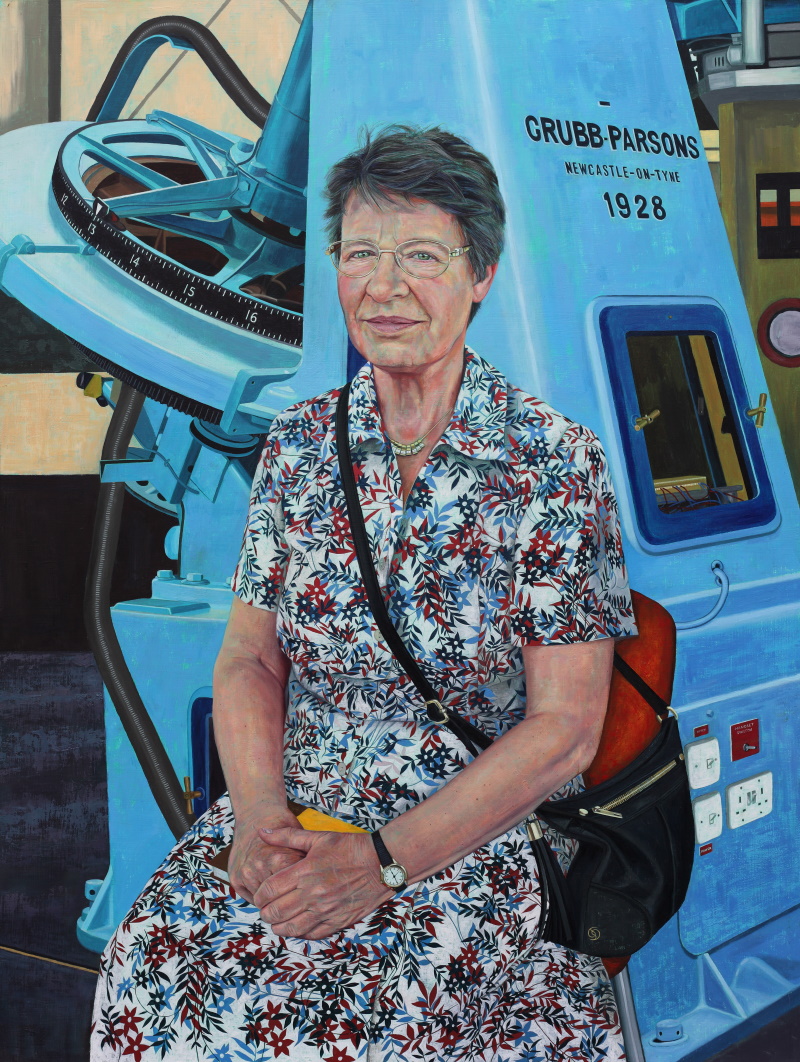Dame Jocelyn Bell Burnell: portrait of trailblazing astrophysicist unveiled by the Royal Society
28 November 2020The Royal Society has unveiled a portrait of trailblazing astrophysicist Dame Jocelyn Bell Burnell, who is credited with one of the most significant scientific discoveries of the 20th century.
Today's unveiling of the oil painting by artist Stephen Shankland marks the date over 50 years ago when Dame Jocelyn, aged just 24, discovered a new type of star while a PhD student at Cambridge University on 28 November 1967.
These rotating neutron stars, named radio pulsars, appear to 'pulse' because the beam of electromagnetic radiation they emit can only be detected when the beam shines on the earth. One day they may be used as 'lighthouses' for navigation across the galaxy.
This discovery was recognised by the Nobel Prize in Physics in 1974, but the award went to Dame Jocelyn’s male supervisor while her contribution was overlooked. However, in 2018 Dame Jocelyn's achievements were celebrated when she was awarded £2.3m prize money for her scientific work. She donated this money to help female students and those from minority and refugee backgrounds follow in her footsteps to become physics researchers.
The Royal Society commissioned the painting as part of an ongoing project to increase the number of female scientists represented in its art collection of fellows and presidents, which dates from the 1670s. It will be on display at the top of the grand staircase in the Society's London home, Carlton House Terrace.
Head of the library, art and archive collection at the Royal Society, Keith Moore, said: "We are very excited that Dame Jocelyn's portrait will take its rightful place beside those of the most distinguished scientists of all time.
“She is a true role-model, much to be admired both in person or in pigment. Not only has she made a ground-breaking contribution to astronomy, but has supported the future of science by generously helping young people, who may feel marginalised, to work in the field of physics. We hope her portrait will inspire these young scientists to feel that they too could become the Dame Jocelyn's of the future.”
The Royal Observatory in Edinburgh, where Dame Jocelyn worked in the 1980s, is seen in the background of the painting and she poses with her travel bag showing how astronomers are among the most widely travelled of scientists. Also included is a 36-inch Grubb-Parsons reflecting telescope, which was the largest of its kind when it was installed at the Royal Observatory in 1930. Now astrophysicists use different observational techniques, and Dame Jocelyn was instrumental in the development of telescopes used today to push the boundaries of knowledge about the universe.
Shankland, a BP Portrait Award winner, painted the portrait in his home studio at Brechin in Scotland. He said: “At my first sitting with Jocelyn, she wore a very rich patterned summer dress, which I immediately liked as it showed the human aspect of her as a scientist. I wanted to convey Jocelyn's warmth in her gaze and capture the kindness and amiable personality she possesses. She was good company, coupled with huge intellect, and that was what I was looking for in her gaze from the painting.
“As a narrative painter, I strive to tell a story within each portrait. Jocelyn had worked for many years at the Royal Observatory in Edinburgh so it fitted exactly into place for me telling her story. I wanted to celebrate the old technology along with Jocelyn's advancements. Her fondness and familiarity with the setting connected beautifully with her legacy.”
The portrait will join those of other female fellows in the Royal Society's collection, including recent commissions of the polymer scientist Dame Julia Higgins by Benjamin Sullivan; and the biochemist Dame Jean Thomas by Keith Breeden. Other artwork includes author and artist Mark Haddon's linocut of the neuroscientist and autism expert Dame Uta Frith and a bust of solar physicist astronomer, Professor Lucie Green by sculptor Marcus Cornish.
Dame Jocelyn was born in Northern Ireland in 1943. After failing her 11-plus, she went to a Quaker boarding school in York where she developed her passion for physics. She graduated in 1965 from the University of Glasgow, with a BSc Hons in Natural Philosophy (physics) and obtained a PhD degree from the University of Cambridge in 1969.
During her long career, Dame Jocelyn has held prestigious academic positions at many universities around the world. She was president of the Royal Astronomical Society from 2002 to 2004 and the first woman to hold the office of president of the Royal Society of Edinburgh from 2014 to 2018. Dame Jocelyn was also the first female president of the Institute of Physics, which administers the funds donated from her prize money. She is currently visiting professor at the University of Oxford and a fellow of Mansfield College. In 2020 she supported the 'STEMinism' campaign by education charity Teach First, which called for more British female scientists to be included in the GCSE science curriculum.
Shankland has painted many well-known figures over the years, including the actor Peter Mullan; professional golfer, Arnold Palmer; Aberdeen Lord Provost, John Reynolds; founder of Primark, Arthur Ryan; and theatre director, Ian McDiarmid. His painting of the scientist Sir Peter Mansfield, inventor of the MRI scanner and winner of the Nobel Prize for Medicine (2003), hangs in the National Gallery.
Born in Irvine, Scotland in 1971, he is a member of the Royal Society of Portrait Painters. In 2004 he received first prize in the National Portrait Gallery BP Portrait Award for a painting of his wife and child, entitled The Miracle.

